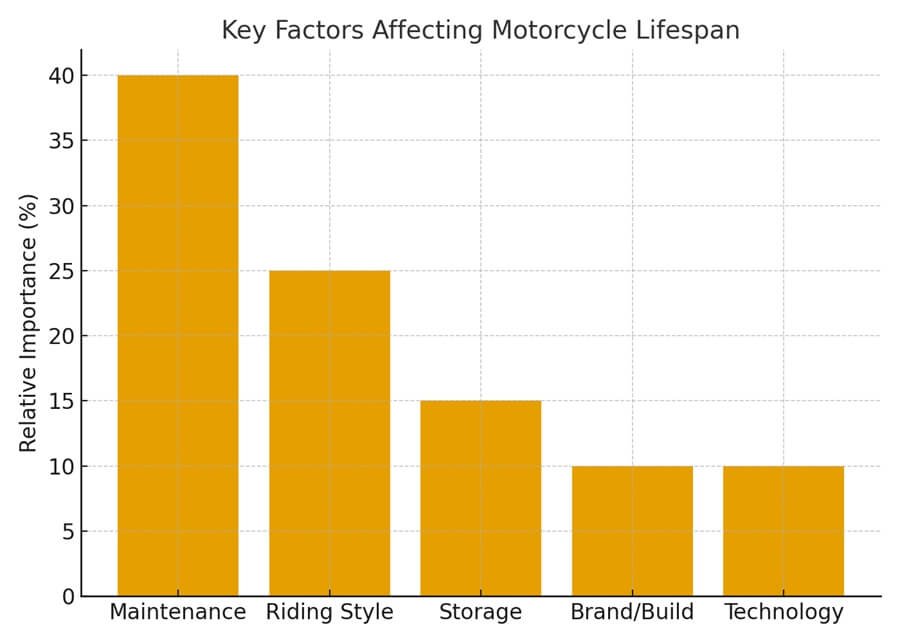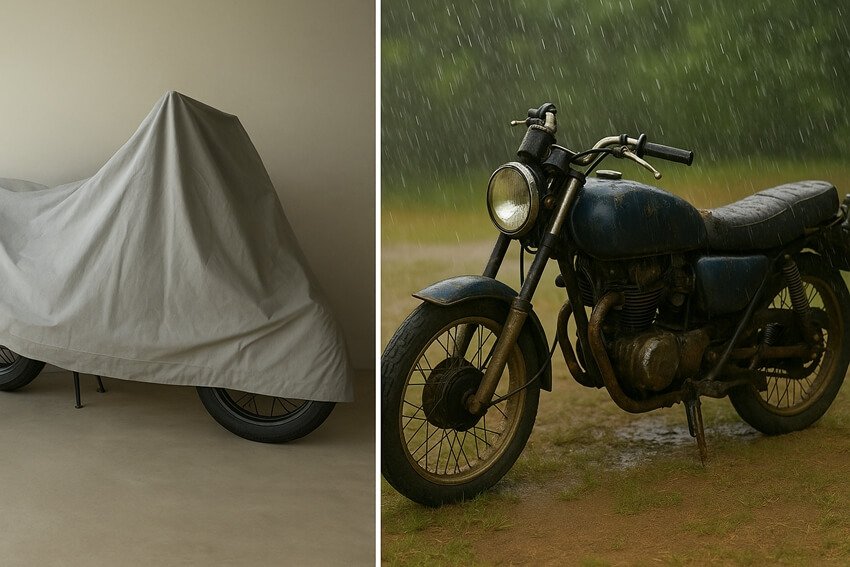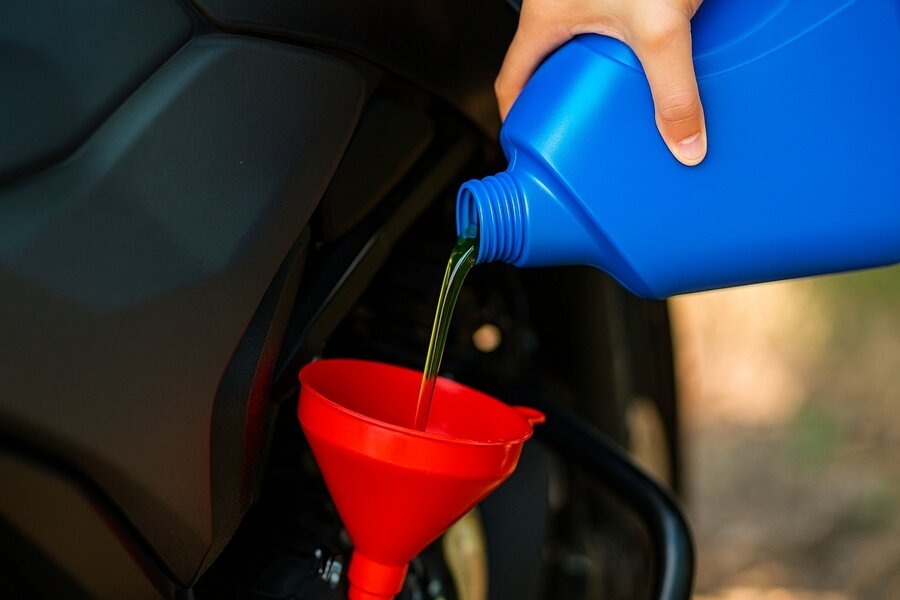Getting your snowmobile’s track adjusted correctly doesn’t have to be complicated. In this guide, we’ll show you the tools, step-by-step instructions, and troubleshooting tips for all major brands — Polaris, Ski‑Doo/Lynx, Arctic Cat, Yamaha, and more. If you do it right, your snowmobile will run great quickly. Why Track Tension Matters Track tension directly affects […]

How Many Miles Can a Motorcycle Last? A Complete Guide to Motorcycle Lifespan
If you’ve been around motorcycles for a while, you’ve probably heard all sorts of numbers thrown around: “A sportbike dies at 20,000 miles.” “My touring bike has 100,000 and still purrs.” Or my favorite — “Once it hits 30,000, you should sell it before it falls apart.”
But is mileage really a death sentence for motorcycles? Not necessarily. In fact, a well-loved machine can outlast all those myths. Let’s dive into what really decides a motorcycle’s lifespan and why that odometer number doesn’t always tell the full story.
Table of Contents
Average Lifespan: Numbers People Quote
The average motorcycle lasts between 20,000 and 100,000 miles, though this can vary significantly depending on the type.
- Touring bikes: Built for endurance; can last 100,000–200,000+ miles with proper care.
- Cruisers: Relaxed engines; typically 80,000–100,000+ miles.
- Sport bikes: High-revving, performance-focused; usually 20,000–30,000 miles, but up to 100,000 miles if well maintained.
- Adventure/Dual-sport bikes: Handle mixed terrain; average around 50,000 miles.
- Dirt bikes: Off-road only; heavy wear leads to the shortest lifespan, often under 20,000 miles.
👉 But here’s where it gets tricky: I’ve seen a Yamaha FJR with 120,000 miles still going strong, and I’ve also seen a Ducati Monster with only 15,000 miles look like it’s on its last legs. Mileage doesn’t tell you the whole story.
Key Factors That Affect Lifespan

motorcycle lifespan factors
Instead of obsessing over numbers, think about these factors:
1. Maintenance and Service
Skip oil changes? Neglect your chain? Forget coolant? Your bike will let you know — and not in a kind way. On the other hand, regular service can make an engine practically bulletproof. A well-maintained sportbike can outlive a poorly maintained cruiser.
- Oil Changes: Synthetic oil and timely changes prevent engine wear.
- Brake System: Pads, rotors, and fluid must be checked regularly.
- Chain & Sprockets: Clean and lube every 300–600 miles.
- Cooling System: Overheating shortens engine life; flush coolant as recommended.
- Battery: Replace every 3–5 years to avoid starting issues.
2. Riding Style
Aggressive redline riding every weekend vs. smooth commuting makes a world of difference. One rider can burn out a clutch in 10,000 miles, another makes it last 40,000 miles.
Aggressive Riding: Frequent redlining, hard braking, and clutch abuse wear components faster.
Smooth Riding: Shifting early, maintaining steady throttle, and avoiding unnecessary strain extends lifespan.
3. Storage Conditions

ideal storage vs poor storage
A bike that sleeps indoors under a cover will age gracefully. Leave it outside through rain and snow? Rust and electrical issues will come knocking.
Ideal Storage: Indoors, covered, stable temperature.
Poor Storage: Outdoors, exposed to rain and humidity, leading to rust, corrosion, and electrical issues.
4. Brand & Build
Some brands just have reputations for longevity. Hondas and Yamahas are famous for it. Ducatis and Triumphs? Fantastic machines, but they usually need more attention.
5. Technological Improvements
Modern motorcycles generally last longer than older ones due to:
- Better metallurgy and materials.
- Synthetic lubricants.
- Tighter manufacturing tolerances.
- Electronic fuel injection (EFI), which reduces engine stress compared to carburetors.
How Many Miles Can a Motorcycle Last in Practice?
There are always those stories that blow averages out of the water:
- A Harley-Davidson rider clocking over 1 million miles on his bike.
- Gold Wing owners bragging about 200,000+ miles without opening the engine.
- I once stumbled across a forum thread where someone had a Kawasaki Concours at 150k and said the only “major surgery” was a new water pump.
These outliers prove one thing: with care, motorcycles can live far longer than most people assume.
Buying a Used Bike: Don’t Fear High Mileage
Here’s the mistake a lot of new riders make — they see 40,000 miles on a used bike and run away. But here’s the truth: a well-kept 40k bike is often better than a 10k one that sat neglected in a garage.
When you’re checking a used motorcycle, look for:
- Service records (oil, valves, chain, fluids).
- How it shifts (gears should be smooth).
- Brake feel (firm, not spongy).
- Signs of storage (rust, faded plastics, dry rot on tires).
High miles with care > low miles with neglect. Remember that.
How to Keep Your Motorcycle Alive Longer
If you love your bike, treat it like it loves you back:

Change oil frequently to keep your motorcycle alive longer
- Regular Maintenance: oil, coolant, brakes, chain. Don’t skip.
- Gentle Warm-Up: don’t rev a cold engine like you’re Rossi on the grid.
- Ride Smoothly: hard launches and constant redlining kill components faster.
- Store Properly: dry, covered, battery tender in the off-season.
And here’s something riders forget: listen to your bike. That weird rattle? That squeak? Don’t ignore it — small fixes now prevent big repairs later.
Conclusion
So, how many miles can a motorcycle last? Honestly, there’s no magic number. Some bikes fade out at 25k, others soldier on past 100k. It all comes down to how it’s ridden, maintained, and stored.
The odometer might be the first thing you glance at, but it shouldn’t be the last. Look at the bike’s history, the rider’s habits, and the care it’s received. Because in the end, a motorcycle’s lifespan isn’t written in miles — it’s written in how much love you give it.

Rodney L is a technical writer and product consultant with over a decade of experience in the motor industry. Rodney is a fan of performance machines that run fast and loud and an expert in all things custom. His numerous articles and write-ups are available at our knowledge base. Whether it’s something wrong with your motorcycle or you are building a custom bike, you can trust Rodney’s experience.
Motorcycle riding is all about the sense of freedom, adventure, and thrill of the open road. But come on—being connected when you ride isn't always an easy thing. Whether you're riding with a buddy, navigating traffic in the city, or long-distance riding, effective communication is crucial. That's where the Fodsports T5 and T6 come in, […]
If you're looking for a new motorcycle intercom system this year, Fodsports has something exciting in store. The company has launched two new Bluetooth helmet intercoms: T1 and T1 Pro. Both models bring upgraded features, sleek design, and high-definition audio quality for riders who want to stay connected, entertained, and safe on the road. But […]
Fodsports T1 and T1 Pro: The Newest Bluetooth Intercoms for Riders. Whether you’re cruising on highways, exploring rugged trails, or commuting daily, clear communication is key. Fodsports is thrilled to launch its latest Bluetooth intercoms: the T1 and T1 Pro. Built for riders who demand reliability, versatility, and crystal-clear sound, these devices redefine how you […]
Many riders who aren't so tall or ladies just starting to ride bikes need to pick out the best Motorcycles for Short Riders and Women. They gotta look for three key things: a seat that's not too high up, a bike that's not too heavy, and something that looks good enough to give them confidence. […]
Fodsports FX 60C vs FX30C Pro: What's new techs are the FX 60C bringing to us? Fodsports is a brand worth-mention for helmet communication and video recording. This brand has established itself as a key player with its innovative Bluetooth camera intercom systems. Recently, Fodsports has released a new camera intercom, the FX 60C. How […]
